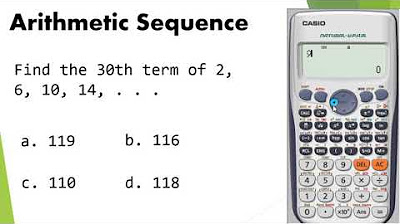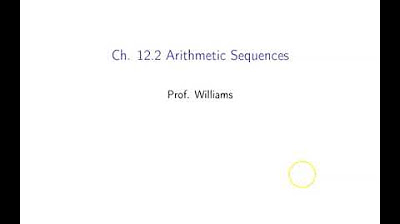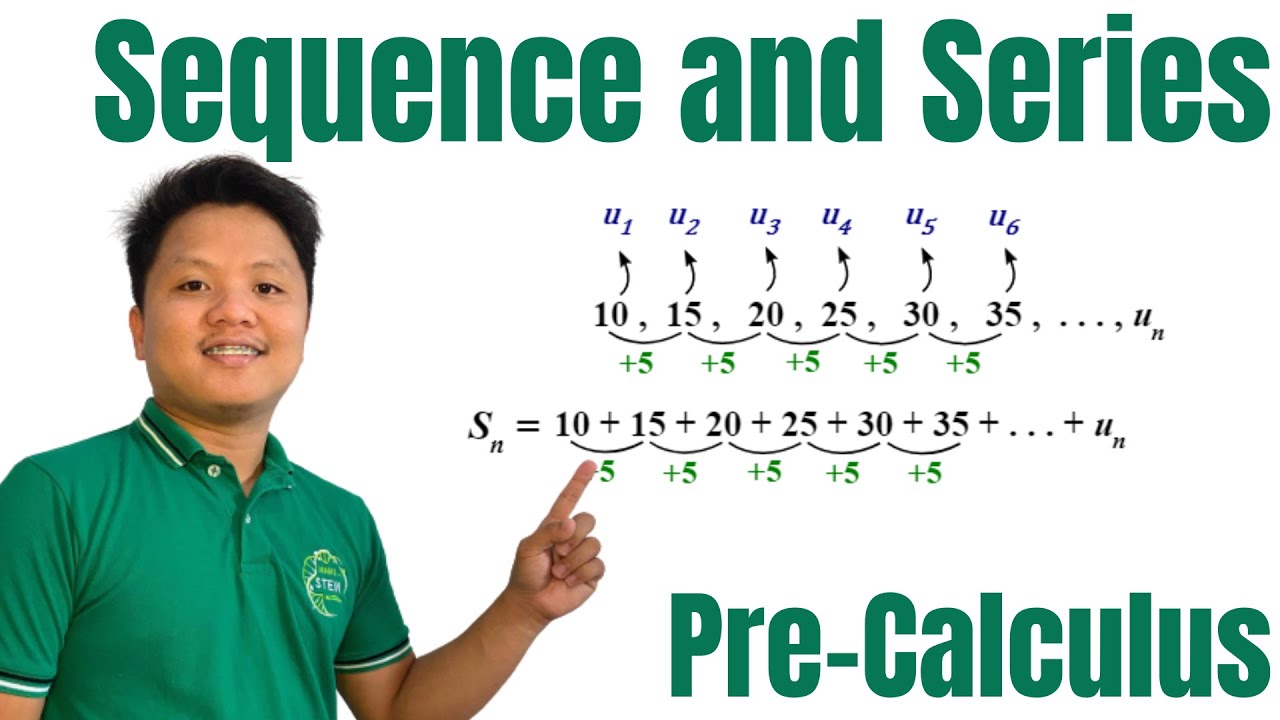2003 AIME II problem 8 | AIME | Math for fun and glory | Khan Academy
TLDRThe video transcript details a mathematical exploration to find the eighth term of a sequence formed by the product of corresponding terms from two arithmetic sequences. The sequences are defined by their first terms, A and B, and common differences, M and N. The script uses known products to set up equations and solve for the terms. By analyzing the given terms 1440, 1716, and 1848, the video derives the values of A, B, M, and N, and ultimately calculates the eighth term of the sequence to be 348, showcasing a step-by-step problem-solving approach.
Takeaways
- 🔢 The sequence in question is formed by multiplying the corresponding terms of two arithmetic sequences.
- 📝 The first arithmetic sequence starts with a term \( A \) and has a common difference \( M \), leading to terms \( A, A+M, A+2M, \ldots, A+7M \).
- 📝 The second arithmetic sequence starts with a term \( B \) and has a common difference \( N \), leading to terms \( B, B+N, B+2N, \ldots, B+7N \).
- 🤔 The challenge is to find the eighth term of the sequence formed by the products of the terms from these two arithmetic sequences.
- 📈 The first term of the sequence is given as \( A \times B = 1440 \).
- 📈 The second term of the sequence is \( (A+M) \times (B+N) = 1716 \).
- 📈 The third term of the sequence is \( (A+2M) \times (B+2N) = 1848 \).
- 🧩 The eighth term of the sequence can be expressed as \( (A+7M) \times (B+7N) \).
- 🔍 By subtracting the equation \( AB = 1440 \) from the equations for the second and third terms, relationships between \( AN + BM + MN \) and \( 2AN + 2BM + 4MN \) are derived.
- 🔍 Solving these relationships yields the values for \( MN \) and \( AN + BM \), which are essential for calculating the eighth term.
- 📊 The final calculation for the eighth term involves adding \( AB \), \( 7 \times (AN + BM) \), and \( 49 \times MN \), with \( AB = 1440 \), \( AN + BM = 348 \), and \( MN = -72 \).
- 🎯 The calculated eighth term of the sequence is found to be 348.
Q & A
What is the sequence in the script about?
-The sequence in the script is about finding the eighth term of a sequence formed by multiplying corresponding terms of two arithmetic sequences.
What is an arithmetic sequence?
-An arithmetic sequence is a sequence of numbers in which each term after the first is obtained by adding a constant difference to the previous term.
How is the eighth term of the given sequence calculated?
-The eighth term of the given sequence is calculated by multiplying the eighth terms of two arithmetic sequences, which are (A + 7M) and (B + 7N).
What are the first three terms of the sequence provided in the script?
-The first three terms of the sequence provided are 1440, 1716, and 1848.
What is the relationship between the terms of the two arithmetic sequences and the terms of the sequence we are interested in?
-The terms of the sequence we are interested in are the products of the corresponding terms of the two arithmetic sequences.
What is the formula for the eighth term of an arithmetic sequence starting with A?
-The formula for the eighth term of an arithmetic sequence starting with A is A + 7M, where M is the common difference.
What is the formula for the eighth term of another arithmetic sequence starting with B?
-The formula for the eighth term of another arithmetic sequence starting with B is B + 7N, where N is the common difference.
How are the terms A, B, M, and N related to the product of the first terms of the two arithmetic sequences?
-The product of the first terms of the two arithmetic sequences (A * B) is equal to the first term of the sequence we are interested in, which is 1440.
What is the equation used to find the value of MN based on the given terms?
-The equation used to find the value of MN is derived from the difference between the equations representing the products of the terms (A + 7M)(B + 7N) and the known terms 1716 and 1848.
How is the final value of the eighth term of the sequence determined?
-The final value of the eighth term is determined by calculating the product (A + 7M)(B + 7N) and adjusting it with the values of AN + BM and MN to get the correct term.
Outlines
🔍 Introduction to Finding the Eighth Term of a Sequence
The video script begins by introducing a problem of finding the eighth term of a sequence formed by the product of corresponding terms of two arithmetic sequences. The first sequence is described with a starting term A and a common difference M, while the second sequence starts with B and has a common difference N. The script outlines the process of finding the eighth term by multiplying the eighth terms of both sequences, which are expressed as A+7M and B+7N, respectively. The first two given terms of the sequence are 1440 and 1716, and the task is to use these to deduce the values of A, B, M, and N.
📚 Establishing Equations for Sequence Terms
The script continues by setting up equations based on the given terms of the sequence. It uses the product of the first terms of both sequences (A*B) to equal 1440. Further equations are established using the second term of the sequence (1716) to relate A+M, B+N, and their product. The script then subtracts 1440 from 1716 to isolate the terms involving M and N, resulting in the equation AN + BM + MN = 276. Another equation is derived from the third term of the sequence (1848), which leads to the equation 2AN + 2BM + 4MN = 408 after subtracting 1440 and dividing by 2. The script then describes the process of solving these equations to find the values of MN and AN + BM.
🧩 Solving for the Eighth Term of the Sequence
In the final paragraph, the script focuses on calculating the eighth term of the sequence. It uses the previously derived equations to find the values of MN and AN + BM, which are essential for determining the eighth term. The script subtracts 49MN (which is -49 times 72, found to be -3528) from 7 times (AN + BM) (which is 7 times 348, calculated to be 2436) and then adds this result to AB (1440). The arithmetic is performed, and the final value for the eighth term of the sequence is determined to be 348. The script concludes with the solution to the problem, providing a clear and concise answer.
Mindmap
Keywords
💡Arithmetic Sequence
💡Sequence
💡Term
💡Product
💡Constant
💡Eighth Term
💡Binomial
💡Multiplication
💡Equation
💡Solving
Highlights
The sequence is formed by multiplying corresponding terms of two arithmetic sequences.
Arithmetic sequences are defined by a constant added to each successive term.
The first arithmetic sequence starts with A and follows the pattern A, A+M, A+2M, ..., A+7M.
The second arithmetic sequence starts with B and follows the pattern B, B+N, B+2N, ..., B+7N.
The product of the corresponding terms of these two sequences gives the terms of the resulting sequence.
The first term of the sequence is A*B, which equals 1440.
The second term of the sequence is (A+M)*(B+N), which equals 1716.
The third term of the sequence is (A+2M)*(B+2N), which equals 1848.
The eighth term of the sequence is (A+7M)*(B+7N).
The expression for the eighth term includes AB, 7an, 7bm, and 49mn.
By knowing AB is 1440, constraints are placed on the values of A, B, M, and N.
The equation AN + BM + MN equals 276 is derived from the second term's expanded form.
The equation 2an + 2bm + 4mn equals 408 is derived from the third term's expanded form.
By subtracting these equations, MN is found to be -72.
Adding 72 to both sides of the equation gives AN + BM equals 348.
The eighth term's expression is simplified to 1440 + 7(AN + BM) - 49MN.
Calculating the values results in the eighth term being 348.
Transcripts
Browse More Related Video

ILLUSTRATING SEQUENCES AND SERIES || PRECALCULUS

Arithmetic Sequences (Precalculus - College Algebra 69)

Geometric Sequences (Precalculus - College Algebra 71)

Caltech in solving nth term of Arithmetic Sequence using Casio fx - 570ES PLUS Calculator

Ch. 12.2 Arithmetic Sequences

Sequence and Series | Terms of Sequence and Associated Series | Pre-Calculus
5.0 / 5 (0 votes)
Thanks for rating: